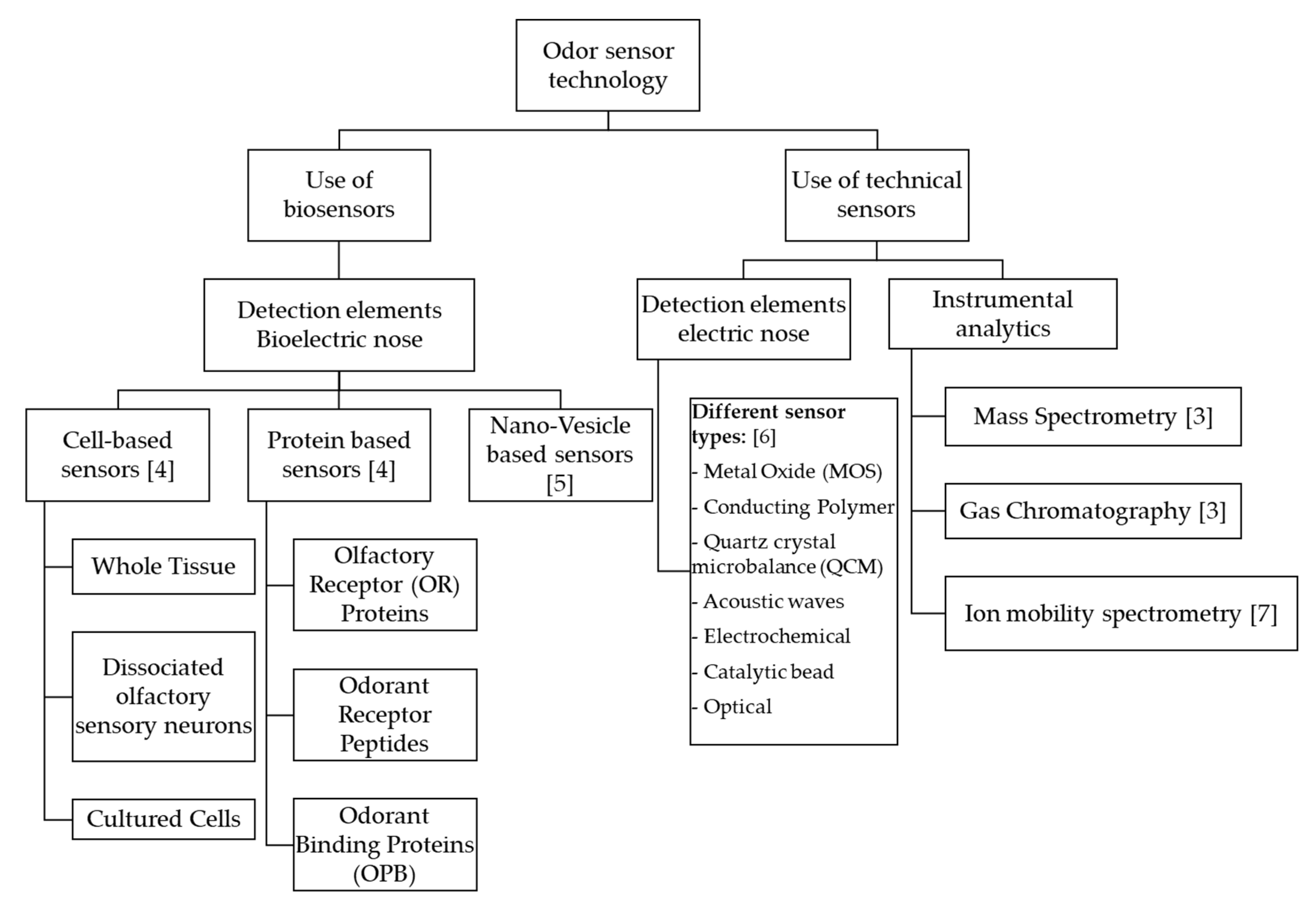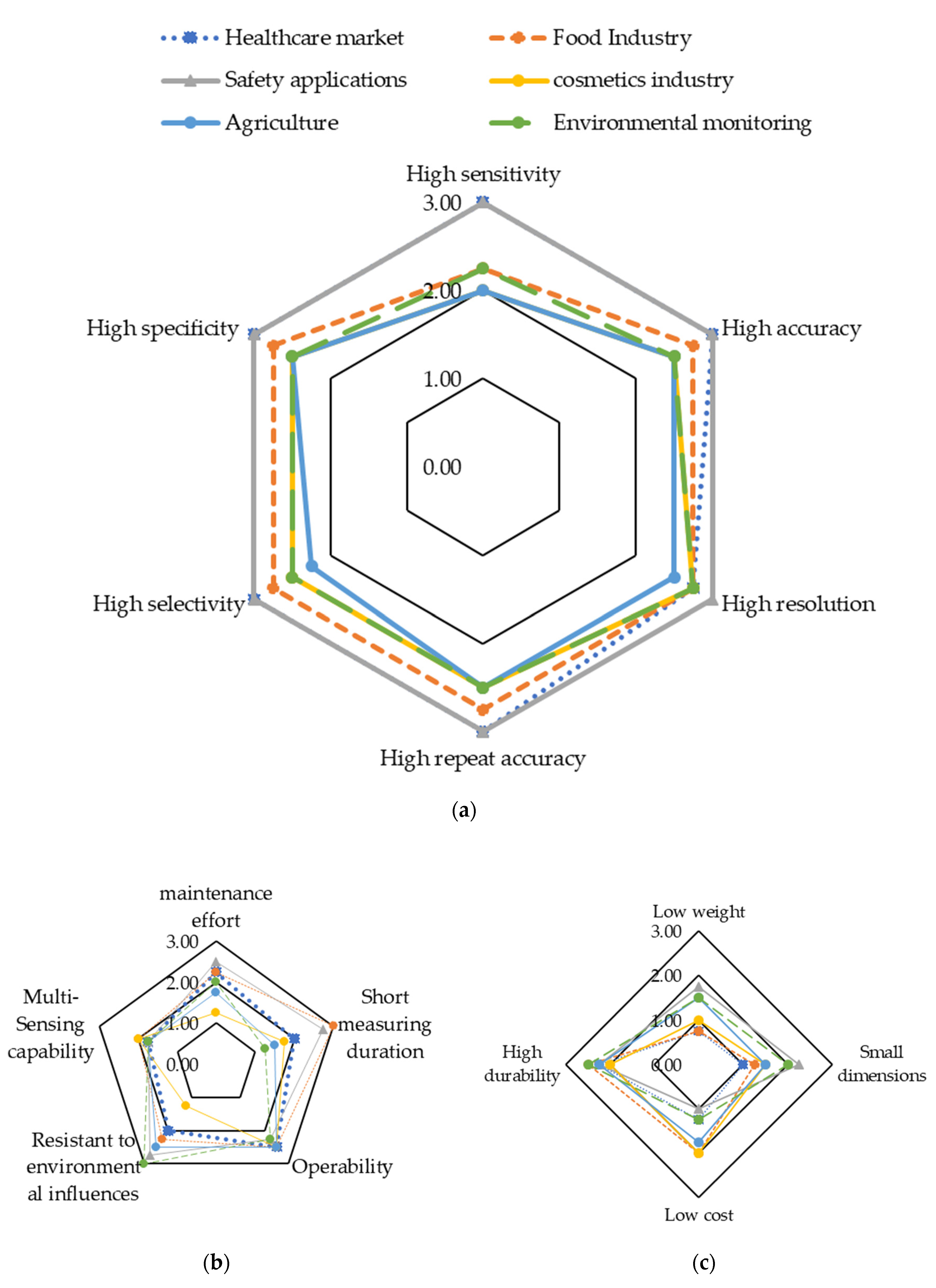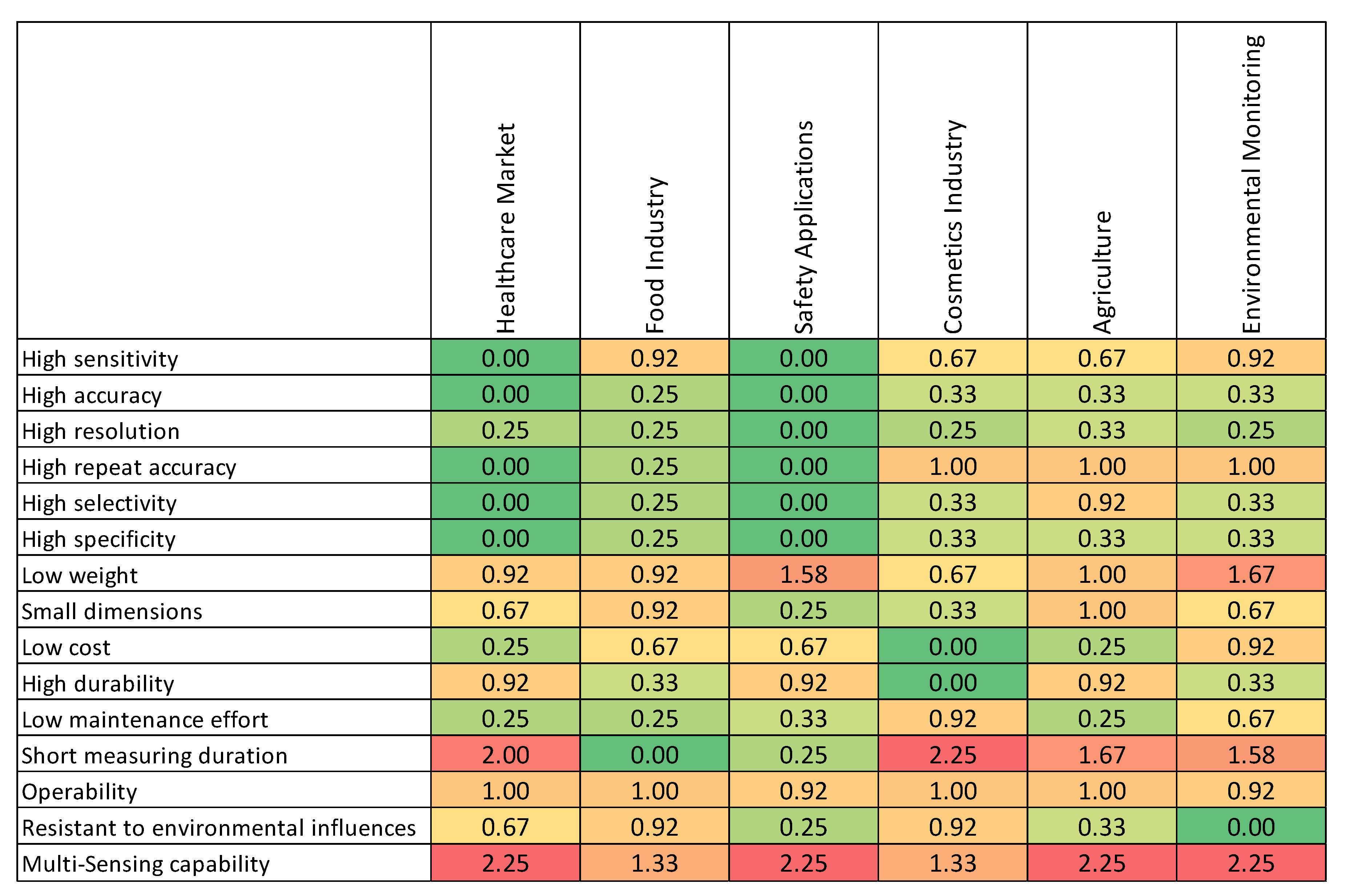Market Perspectives and Future Fields of Application of Odor Detection Biosensors—A Systematic Analysis †
Abstract
:1. Introduction
- What are the specific market potentials of odor detection biosensors?
- What are therefore the most promising application fields for odor detection biosensors?
2. Basics
2.1. Types of Odor Sensing Technologies
2.2. Technical Performance Criteria of Odor Sensing Technologies
- Sensitivity: Describes the degree to which the output signal (measured value) changes in relation to the change of the input signal (measuring signal),
- Accuracy: Describes the maximum deviation of the sensor’s measurement value from the real (ideal) value,
- Selectivity: Describes the response of the sensor to a certain group of analytes or one specific analyte,
- Specificity: Indicates the probability that the measured value is falsely positive or falsely negative,
- Resolution: Describes the smallest measurable change the sensor is able to register,
- Repeatability: Indicates the error that occurs with repeated measurements, under the same initial situation,
- Lifetime: Describes the period of time during which the sensor remains functional,
- Reliability: Describes the performance of the sensor that must be maintained over a defined period,
- Resistance to environmental influences or stability: Describes the accuracy of the measurement results in case of changing environmental influences, such as temperature, humidity, radiation or magnetism,
- Maintenance effort: Describes the overall effort of measures that keep the system in a functional state,
- Multi-sensing capability: Describes the ability to measure several different substances in parallel,
- Cost: Describes the monetary costs of the manufacturing process for materials and the production process,
- Dimensions: Describes the flexibility of relevant, characteristic geometric dimensions of the sensor shape,
- Weight: Mass of the body in kg per measuring unit or sensor,
- Operability: Describes the simplicity of use,
- Measurement duration: The time required to complete a measurement process.
2.3. Markets and Application Fields for Biosensors
- Healthcare: The healthcare market includes the ambulatory and stationary achievement contribution by established physicians, dentists, and hospitals, as well as other service providers [12]. In 2019, the health care system in Germany had a turnover of EUR 86.5 billion [13]. In 2018, 48,346 companies in Germany were active in the healthcare sector [14]. One example of a future field of application is diagnostics. Sick people excrete different VOCs compared to healthy people. These VOCs are used as biomarkers and can be identified by breath, urine, and other body fluids. A diagnosis based solely on a patient’s odor requires very accurate diagnostic equipment [15]. Odor sensors prove to be a suitable diagnostic tool when it comes to diagnosing diseases. There is a great demand for non-invasive diagnostic methods in the healthcare sector. These sensor devices should be able to perform real-time monitoring, and they should be portable and inexpensive [16].
- Food industry: Food industry comprises food and feed manufacturers together with the beverage industry. Altogether, there are about 6000 companies with more than 20 employees in the German food industry [17]. In 2018, these companies employed more than half a million people. With an annual turnover of almost EUR 180 billion, the food industry is one of the largest industries in Germany [18]. The odor sensors in this industry should enable fast detection of quality changes during production. During quality control, impurities and pathogens are identified. Furthermore, the correct composition of the produced food and its smell and taste can be analyzed [19].
- Agriculture: Agriculture is the economic activity where soil, livestock, labor, and know-how produce agricultural products that ensure the supply of plant and animal food to the people [20]. In 2018, there were 266,600 active companies in Germany [21]. They had a turnover of EUR 38.3 billion in 2018 [22]. Odor sensors can be used in agriculture to determine the quality of products and stocks based on odors or VOCs, or to detect pests and other negative influences already in the field [3].
- Cosmetics industry: Cosmetics include all products that have a healing effect but are also used for beauty care. The industry is mainly determined by the large consumer goods groups. In 2018, there were 137 companies in the German industry for the production of cosmetics [23], generating sales of approximately EUR 6.4 billion [24]. Fields of application for odor sensors in the cosmetics industry are mainly quality control of production goods. Odor sensors can also be used in production to check the correct composition of the products, in order to be able to analyze odors and develop them more specifically, for example [3].
- Safety applications: Safety applications are all applications that aim to detect hazardous substances. Smells contain important information about the environment and activities relevant to military and safety-oriented applications. This includes the detection of explosive materials or hazardous chemicals. However, an odor sensor can also be used for crime prevention tasks, such as security checks at airports or drug detection [25]. In 2021, the security industry in Germany is forecast to generate sales of EUR 9.2 billion [26].
- Environmental monitoring: In environmental monitoring, indoor and outdoor air is analyzed in order to detect air quality issues caused by harmful VOCs. These issues occur, for example, during the manufacturing of furniture [27]. The detection of harmful and toxic substances is also one of the areas of application for odor sensors. Furthermore, air quality and factory emissions can be monitored as well as the quality of ground and surface water. Because of increased environmental awareness and pollution, the market for technological solutions for environmental monitoring applications is growing [19]. The turnover of the German environmental protection industry in 2018 amounted to EUR 71 billion [28].
3. Methodology
4. Results
4.1. Performance Profile of Biosensors for Odor Detection
4.2. Requirement Profiles for Different Application Fields of Odor Sensing Technologies
5. Conclusions
6. Summary and Outlook
Acknowledgments
References
- Dung, T.T.; Oh, Y.; Choi, S.-J.; Kim, I.-D.; Oh, M.-K.; Kim, M. Applications and Advances in Biosensors for Odor Sensing. Sensors 2018, 18, 103. [Google Scholar] [CrossRef] [PubMed]
- Bohbot, J.D.; Vernick, S. The Emergence of Insect Odorant Receptor-Based Biosensors. Biosensors 2020, 10, 26. [Google Scholar] [CrossRef] [PubMed]
- Büttner, A. Springer Handbook of Odor; Springer International Publishing: Cham, Switzerland, 2017; pp. 459–482. [Google Scholar]
- Cave, J.W.; Wickiser, J.K.; Mitropoulos, A.N. Progress in the development of olfactory-based bioelectronic chemosensors. Biosens. Bioelectron. 2019, 123, 211–222. [Google Scholar] [CrossRef] [PubMed]
- Son, M.; Park, T.H. The biosensor and tongue using olfactory and taste receptors: Analytical tools for food quality and safety assessment. Biotechnol. Adv. 2018, 36, 371–379. [Google Scholar] [CrossRef] [PubMed]
- Karakaya, D.; Ulucan, O.; Turkan, M. Electronic Nose and Its Applications: A Survey. Int. J. Autom. Comput. 2020, 17, 179–209. [Google Scholar] [CrossRef]
- Scheider-Häder, B.; Müller, M.; Hambacher, E.; Wiech, H.; Wortelmann, T. Instrumental Sensor Technology in the Food Industry: Part 1: Electronic Noses: (German). 2015. Available online: https://www.dlg.org/de/lebensmittel/themen/publikationen/expertenwissen-sensorik/elektronische-nasen/ (accessed on 3 October 2020).
- Röck, F.; Weimar, U. Electronic nose and signal acquisition: (german). In Information Fusion in Measurement and Sensor Technology; Beyerer, J., Ed.; Universitätsverlag: Karlsruhe, Germany, 2006; pp. 261–278. [Google Scholar]
- Karunakaran, C.; Bhargava, K.; Benjamin, R. (Eds.) Biosensors and Bioelectronics; Elsevier: Amsterdam, The Netherlands, 2015. [Google Scholar]
- Fraden, J. Sensor Characteristics. In Handbook of Modern Sensors; Fraden, J., Ed.; Springer International Publishing: Cham, Switzerland, 2016; pp. 35–68. [Google Scholar]
- Frost & Sullivan (Ed.) Analysis of the Global Biosensors Market: Biosensors Monitoring Stimulates Prevention and Control; Research Code: NEE9-01-00-00-00; Mountain View, CA, USA, 2015. [Google Scholar]
- Werding, M. Definition: Healthcare: (German). 2018. Available online: https://wirtschaftslexikon.gabler.de/definition/gesundheitswesen-34513/version-258015 (accessed on 3 October 2020).
- Statistisches Bundesamt. Sales Development in the Healthcare Sector in Germany in the Years from 2006 to 2023: (German), Cited after de.statista.com. 2019. Available online: https://de.statista.com/statistik/daten/studie/247979/umfrage/prognose-zum-umsatz-im-gesundheitswesen-in-deutschland/ (accessed on 12 October 2020).
- Statista. Healthcare 2020: Statista Industry Report: (German)- WZ-Code 86. 2020. Available online: https://de.statista.com/statistik/studie/id/62/dokument/gesundheitswesen/#:~:text=Statista%20Branchenreport%20%2D%20WZ%2DCode%2086&text=Im%20Jahr%202020%20bel%C3%A4uft%20sich,auf%20die%20Subbranche%20%22Krankenh%C3%A4user%22 (accessed on 12 October 2020).
- Chen, S.; Wang, Y.; Choi, S. Applications and Technology of Electronic Nose for Clinical Diagnosis. OJAB 2013, 2, 39–50. [Google Scholar] [CrossRef]
- Capelli, L.; Taverna, G.; Bellini, A.; Eusebio, L.; Buffi, N.; Lazzeri, M.; Guazzoni, G.; Bozzini, G.; Seveso, M.; Mandressi, A.; et al. Application and Uses of Electronic Noses for Clinical Diagnosis on Urine Samples: A Review. Sensors 2016, 16, 1708. [Google Scholar] [CrossRef] [PubMed]
- Statistisches Bundesamt. Number of Companies in the Food Industry in Germany in the Years 2008 to 2019: (greman), Cited after de.statista.com. 2020. Available online: https://de.statista.com/statistik/daten/studie/321182/umfrage/betriebe-in-der-lebensmittelindustrie-in-deutschland/ (accessed on 12 October 2020).
- Statistisches Bundesamt. Sales of the Food Industry in Germany in the Years 2008 to 2019: (German), Cited after de.statista.com. 2020. Available online: https://de.statista.com/statistik/daten/studie/75611/umfrage/umsatz-der-deutschen-ernaehrungsindustrie-seit-2008/ (accessed on 12 October 2020).
- Wasilewski, T.; Gębicki, J.; Kamysz, W. Advances in olfaction-inspired biomaterials applied to biosensors. Sens. Actuators B Chem. 2018, 257, 511–537. [Google Scholar] [CrossRef]
- Berwanger, J. Definition: Agriculture: (German); 2018. Available online: https://wirtschaftslexikon.gabler.de/definition/landwirtschaft-41331#definition (accessed on 3 October 2020).
- Statistisches Bundesamt. Number of Farms in Agriculture in Germany in the Years 1975 to 2019: (German). Cited after de.statista.com. 2020. Available online: https://de.statista.com/statistik/daten/studie/36094/umfrage/landwirtschaft---anzahl-der-betriebe-in-deutschland/ (accessed on 12 October 2020).
- Statistisches Bundesamt. Net Sales of Agriculture in Germany in the Years 2002 to 2018: (German). Cited after de.statista.com. 2020. Available online: https://de.statista.com/statistik/daten/studie/323340/umfrage/umsatz-der-landwirtschaft-in-deutschland/ (accessed on 12 October 2020).
- Statistisches Bundesamt. Number of Companies in the German Industry Producing Personal Care Products and Fragrances in the Years 2008 to 2019: (German), Cited after de.statista.com. 2020. Available online: https://de.statista.com/statistik/daten/studie/256938/umfrage/betriebe-in-der-deutschen-kosmetik-und-koerperpflegeindustrie/ (accessed on 12 October 2020).
- Statistisches Bundesamt. Sales of the German Industry for the Production of Personal Care Products and Fragrances in the Years 2008 to 2019: (German), Cited after de.statista.com. 2020. Available online: https://de.statista.com/statistik/daten/studie/256917/umfrage/umsatz-der-deutschen-kosmetik-und-koerperpflegeindustrie/ (accessed on 12 October 2020).
- Koniku-Intelligence is Natural: Application. 2019. Available online: https://koniku.com/applications (accessed on 12 October 2020).
- Statistisches Bundesamt. Forecast Sales Development in the Security Industry in Germany in the Years from 2007 to 2021: (German), Cited after de.statista.com; 2020. Available online: https://de.statista.com/statistik/daten/studie/248225/umfrage/prognose-zum-umsatz-in-der-sicherheitsbranche-in-deutschland/ (accessed on 12 October 2020).
- Brown, N. Monitoring the Indoor Air Quality: (German); In Elektronik Industrie; Hüthig: Heidelberg, Gremany, 2017; pp. 62–85. [Google Scholar]
- Statistisches Bundesamt. Sales of the German Environmental Protection Industry in the Years 2008 to 2018: (German), Cited after de.statista.com. 2020. Available online: https://de.statista.com/statistik/daten/studie/240324/umfrage/umsatz-mit-umweltschutz-klimaschutzguetern-in-deutschland/ (accessed on 12 October 2020).
- Prickril, B.; Rasooly, A. Biosensors and Biodetection; Springer: New York, NY, USA, 2017. [Google Scholar]
- Hurot, C.; Scaramozzino, N.; Buhot, A.; Hou, Y. Bio-Inspired Strategies for Improving the Selectivity and Sensitivity of Artificial Noses: A Review. Sensors 2020, 20, 1803. [Google Scholar] [CrossRef]
- Son, M.; Lee, J.Y.; Ko, H.J.; Park, T.H. Biosensor: An Emerging Tool for Odor Standardization. Trends Biotechnol. 2017, 35, 301–307. [Google Scholar] [CrossRef] [PubMed]
- Wasilewski, T.; Gębicki, J.; Kamysz, W. Biosensor: Current status and perspectives. Biosens. Bioelectron. 2017, 87, 480–494. [Google Scholar] [CrossRef] [PubMed]
- Beccherelli, R.; Zampetti, E.; Pantalei, S.; Bernabei, M.; Persaud, K.C. Design of a very large chemical sensor system for mimicking biological olfaction. Sens. Actuators B Chem. 2010, 146, 446–452. [Google Scholar] [CrossRef]
- Du, L.; Wu, C.; Liu, Q.; Huang, L.; Wang, P. Recent advances in olfactory receptor-based biosensors. Biosens. Bioelectron. 2013, 42, 570–580. [Google Scholar] [CrossRef] [PubMed]
- Oh, J.; Yang, H.; Jeong, G.E.; Moon, D.; Kwon, O.S.; Phyo, S.; Lee, J.; Song, H.S.; Park, T.H.; Jang, J. Ultrasensitive, Selective, and Highly Stable Biosensor That Detects the Liquid and Gaseous Cadaverine. Anal. Chem. 2019, 91, 12181–12190. [Google Scholar] [CrossRef] [PubMed]
- Tan, J.; Xu, J. Applications of electronic nose (e-nose) and electronic tongue (e-tongue) in food quality-related properties determination: A review. Artif. Intell. Agric. 2020, 4, 104–115. [Google Scholar] [CrossRef]
- Pelosi, P.; Zhu, J.; Knoll, W. From Gas Sensors to Biomimetic Artificial Noses. Chemosensors 2018, 6, 32. [Google Scholar] [CrossRef]
- Yang, A.; Yan, F. Flexible Electrochemical Biosensors for Health Monitoring. ACS Appl. Electron. Mater. 2020. [Google Scholar] [CrossRef]
- Wilson, A.D.; Baietto, M. Applications and advances in electronic-nose technologies. Sensors 2009, 9, 5099–5148. [Google Scholar] [CrossRef] [PubMed]




| Properties | Fulfillment | Rating | References |
|---|---|---|---|
| High sensitivity | Because of the natural binding of olfactory receptors (ORs) with the specific ligand, the sensor can react even to very small amounts of analyte. | 2 | [1,29,30,31] |
| High accuracy | High accuracy due to natural binding of OR with specific ligand. | 2 | [1,29] |
| High resolution | Substances can be detected in very high resolutions at a level of nanomoles (or lower). | 2 | [1,32,33,34] |
| High repeat accuracy | Currently there are still problems with the stability of the results. No high repeat accuracy can be guaranteed yet. | 0 | [32,35,36] |
| High selectivity | It can be tested very specifically for certain substances. | 2 | [1,3,30,31] |
| High specificity | Good results for falsely positive and falsely negative measurements. | 2 | [1,3] |
| Low weight | A compact and light design for biosensors in comparison to analytical instruments allows online monitoring. Portable devices (sensors on chip) are currently in testing phases. No advantages. Probably no significant advantages over electronic noses to be expected. | 1 | [19,31] |
| Small dimensions | Analytical instruments are large benchtop systems permanently installed in laboratories. There are electric noses with a diameter of a few cm. The same is possible for biosensors. Probably no significant advantages over electronic noses to be expected. | 1 | [31,35] |
| Low cost | The manufacturing costs for biological odor sensors are not yet finally known. Because of high research and development costs and complex production processes, a high sales price can be expected. For comparison, analytical instruments can cost up to USD 30,000. Electronic noses are available from USD 200. | 1 | [2,4,31,32,37] |
| High durability | Sensors, which use cells as bioreceptors, currently have a lifetime of just about a few weeks. The durability of these systems, especially for use as industrial sensors, are not reported. | 0 | [1,3,30,32,37] |
| Low maintenance effort | Bioreceptors must be replaced regularly. Replacement receptors must be stored correctly. | 0 | [4,32,38] |
| Short measuring duration | Measuring times for biosensors are reported from 5–30 s. Total measuring process takes 5 m due to sample preparation and pauses between measurements. This is comparatively faster than analytical instruments but in the same range as electronic noses. | 1 | [1,4,31] |
| Operability | Usability cannot be conclusively evaluated yet. However, odor sensors allow a non-invasive measuring method that does not require the extraction of sample material. | 1 | [16,31,39] |
| Resistant to environmental influences | Sensors must be protected against environmental influences. Susceptible to humidity and temperature fluctuations. | 0 | [3] |
| Multi-sensing capability | Biosensors are able to measure several different substances simultaneously. | 2 | [29,30,39] |
Publisher’s Note: MDPI stays neutral with regard to jurisdictional claims in published maps and institutional affiliations. |
© 2020 by the authors. Licensee MDPI, Basel, Switzerland. This article is an open access article distributed under the terms and conditions of the Creative Commons Attribution (CC BY) license (https://creativecommons.org/licenses/by/4.0/).
Share and Cite
Full, J.; Delbrück, L.; Sauer, A.; Miehe, R. Market Perspectives and Future Fields of Application of Odor Detection Biosensors—A Systematic Analysis. Proceedings 2020, 60, 40. https://doi.org/10.3390/IECB2020-07029
Full J, Delbrück L, Sauer A, Miehe R. Market Perspectives and Future Fields of Application of Odor Detection Biosensors—A Systematic Analysis. Proceedings. 2020; 60(1):40. https://doi.org/10.3390/IECB2020-07029
Chicago/Turabian StyleFull, Johannes, Lukas Delbrück, Alexander Sauer, and Robert Miehe. 2020. "Market Perspectives and Future Fields of Application of Odor Detection Biosensors—A Systematic Analysis" Proceedings 60, no. 1: 40. https://doi.org/10.3390/IECB2020-07029
APA StyleFull, J., Delbrück, L., Sauer, A., & Miehe, R. (2020). Market Perspectives and Future Fields of Application of Odor Detection Biosensors—A Systematic Analysis. Proceedings, 60(1), 40. https://doi.org/10.3390/IECB2020-07029




